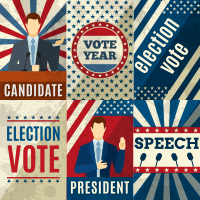

The Rise of Technology Usage In Political Campaigns
Throughout modern history, the presidential candidates who are tech-savvy have proven to gain a distinct advantage over those giving it the cold shoulder. A few interesting highlights are listed below, courtesy of a recent Adweek article, proving that taking big risks paid off for most.
1. Believe it or not, the first president to change the way we look at political campaigns and their promotion was Calvin Coolidge. Even though he stayed at home to deliver them, his radio broadcasts in 1924 reached more voters than his opponents.
2. TV took over in 1952 with Eisenhower’s “Eisenhower Answers America” campaign. He smartly had his spots run before popular TV programs instead of the typical half-hour speeches popular in the day.
3. In 1960, Kennedy trumped (no pun intended for one of today’s vocal candidates) Nixon during the first nationally televised debate.
4. In 1964, the first negative ad against an opponent ran with Lyndon Johnson’s “Daisy,” that portrayed Barry Goldwater’s campaign in a negative light. Although it only aired once, but it received so much buzz and talk that it has been credited with turning the election in Johnson’s favor.
5. Big jump to 1996 when the introduction of Robocall outreach to voters, utilized in Clinton’s campaign. Annoying as they are, they are proven to get loyalists to the polls.
6. In 2003, Howard Dean first used email as a campaign fundraising tool, taking in more than $30 million.
7. Obama’s election in 2008 has come to be known as the internet election. It was the first time more than half of the voting population went online to connect to politics. The Obama campaign went on to blast personalized messages to a database of 10 million and accrued 14.5 million hours of free advertising on YouTube™.
8. For Obama’s second term in 2012, he had twice as many Facebook likes and nearly 20 times as many retweets as Romney. His campaign mastered engaging voters through something relevant to them, social media.
9. This year, you’ll see microtargeting come into play when it comes to voting, using databases to pinpoint where party voters live and capitalizing on it, similar to geofencing.
10. With the rise of technology, one can only begin to see where political advertising pops up next. One thing is certain: there is no such thing as political campaigning as usual!




